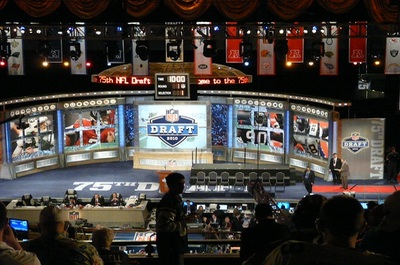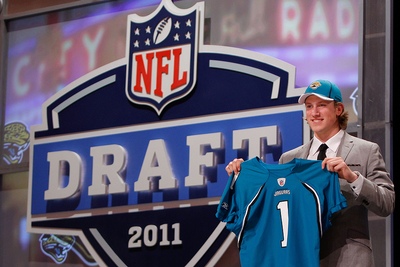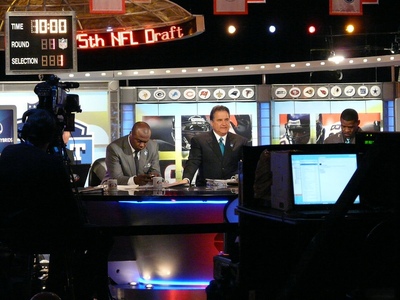
American football is the biggest sport in the United States and the National Football League (NFL) – the sport’s biggest professional league – is watched and enjoyed by fans around the globe. But unlike many professional sports with which UK fans might be more familiar, the way players progress to the professional ranks of the NFL is rather different to something like football (i.e. soccer). Instead of teams simply buying the best young talent or bringing them up through their own club’s academies (as is the norm for Premier League football clubs, for instance), NFL teams – or franchises, if you prefer – rely on something a little more complicated: the NFL Draft.
In this article, we’ll explain what the NFL Draft is, the basics of how it all works and why it is thought by many to be a much fairer system than simply allowing the richest clubs to buy the best players (as happens in soccer). We’ll also throw in details of the best draft picks of all time… and anyone with even a minor interest in NFL will not have to think too long about which player makes it to the top of that list.
The NFL Draft In A Nutshell

The NFL draft – or the Player Selection Meeting, to give it its official title – is the main way NFL teams acquire new players. It is not the only way, however, as teams can also acquire players who are out of contract (i.e. free agents) or by trading players with other teams.
These new players for the NFL draft come from college football which, in the absence of minor leagues (such as those that exist in baseball), serves as the de facto second tier of American football. The NFL teams are each given a position in the order in which they can pick players which is, crucially, based upon where they finished in the previous year in the standings. Unlike in other sports, for example Formula 1, where excellence in qualifying is rewarded with pole position, the draft favours the weaker teams. So the Super Bowl winner would have the last pick whereas the team that had the worst record in the NFL would be granted the first pick.
The first draft took place in 1936, since when various tweaks have been made to the rules and mechanisms by which the process works. The draft itself is a major event in the NFL off-season and usually takes place in late April or early May and attracts millions of TV viewers. The whole notion of the draft is to attempt to ensure that a small number of franchises do not dominate the NFL year after year (as clearly happens with soccer, for instance with Real Madrid and Barcelona in Spain’s La Liga or Paris St Germain in France’s Ligue 1). But let’s delve a little deeper into how the draft process works and whether it really does level up the playing field for NFL sides.
How Does The NFL Draft Work?
Here we’ll outline in a little more detail the main points of how the NFL draft works, though note that rules and procedures can and do change from time to time in relation to various aspects of the draft.
Who Gets Drafted?
To be eligible for the NFL draft, American football players must have graduated from high school at least three years before. In theory, such players are not required to have attended college (university), but in practice, almost all drafted players have played college football in either the United States or (less commonly) Canada. Eligible players then apply to be picked for the draft and then have to jump through all kinds of hoops, including the NFL Scouting Combine at which prospective draft players might find themselves literally jumping through hoops. Based on the Combine, scouting reports and various other factors (such as reports from the NFL Draft Advisory Board), the players deemed the best of that year’s crop will be invited by the NFL to take part in the draft.
Which Team Picks First?
 The format of the NFL draft has changed over the years but currently there are seven rounds of draft picks that take place over two or three days. As mentioned above, the order in which the 32 teams from the NFL are able to make picks is based on their performance during the previous season, with their win-loss record the key stat. If there are ties between teams on that metric, a number of tie-breakers are used in order to assess which teams get which picks. These include the relative strength of the opposition they faced, head to head stats and other factors.
The format of the NFL draft has changed over the years but currently there are seven rounds of draft picks that take place over two or three days. As mentioned above, the order in which the 32 teams from the NFL are able to make picks is based on their performance during the previous season, with their win-loss record the key stat. If there are ties between teams on that metric, a number of tie-breakers are used in order to assess which teams get which picks. These include the relative strength of the opposition they faced, head to head stats and other factors.
Teams that did not make the playoffs are allocated draft picks one to 18 (based on their relative records, the worst team getting pick one, the best of those getting 18). The teams that were eliminated in the Wild Card round are allocated picks 19 to 24. Those eliminated in the Divisional round are given 25 to 28. The Conference runners-up are given 29 and 30. The Super Bowl runner-up gets pick 31 and the Super Bowl champions get the final pick, 32.
The order of picks remains the same through all seven rounds of the draft, so the worst team in the NFL from the previous season gets first dibs on the player they perceive to be the best in each round. Things are slightly different for teams with the same records within their tiers who were separated by the various tie-breaks. In this scenario, teams would “cycle” their picks after the first round.
So, for instance, imagine the Chicago Bears, the Miami Dolphins and the Seattle Seahawks all had identical records but were deemed to have finished in pick positions three to five based on the tie-breaks. The Bears would get the third pick in round one, the Dolphins would get the fourth pick and the Seahawks would get the fifth pick. In the second round, the Dolphins would go third, the Seahawks fourth and the Bears fifth. This rotation would continue through the rounds.
The notion of giving the poorest teams from the previous season the chance to acquire the best players in the draft is the crucial component of the system and is what – in theory at least – helps add some level of fairness to NFL.
What Happens During The Draft?

Due to the various scouting reports, the Combine and various player visits, most teams will have a solid idea about the players they want to acquire through the draft before it gets underway. Each team sends various representatives to the draft itself and they are tasked with securing the best players they can (whether on their initial wishlist or the best alternatives they can get).
To keep the process moving along – and to make it more interesting for the large TV audience – there is a timer that is in play during the draft which goes from one team to the next. So when the draft commences, the team with the first pick in the first round has 10 minutes to make their decision on the player they want. Once they have made their pick, the next team’s 10-minute clock begins, and so on until all the teams have made their first-round picks. Teams then get seven minutes per pick in the second round, five minutes in rounds three to six and four minutes in the seventh round.
If a team doesn’t make its selection within its time, it runs the risk of the next team picking the player they wanted before them. Though it doesn’t stop the first team from making a selection if their chosen player is still available, that is to say, they don’t lose their pick if they run out of time. Clearly, if someone ahead of you in line to make picks takes a player on your wishlist, there is some serious – and quick – thinking required to pick the best alternative, especially when it gets to the later rounds when teams might have less information on some players.
What Are Pick Trades?
To give teams a little more flexibility, they may make deals with one another by trading certain picks for others. These pick trades can occur between teams before the draft has commenced or while the draft is going on and it is not subject to any time limits. An example of a pick trade might be a team giving up the right for a pick in round one in exchange for the other team’s picks in rounds three and four. Or teams could even trade picks in the current draft for picks in the following year’s draft if they so wished and both parties deemed it beneficial.
Additional Picks
As well as the standard 32 picks in each of the seven rounds, there are also 32 so-called compensatory picks. These are applied based on whether teams lost or gained any free agents (players out of contract). If they lost more than they gained in the previous year, they gain between one and four picks that would apply to rounds three to seven. Note that these compensatory picks can also be traded. The round to which the picks apply is calculated based on factors including the player salaries.
A resolution was passed by the NFL in 2020 that awards extra picks to teams who develop minority candidates in certain coaching or general manager roles. This Resolution JC-2A was put in place to help minorities reach the upper echelons of the franchises’ hierarchy and built on previous resolutions that were deemed to not go far enough.
Forfeiting Picks
Note that as well as teams being awarded additional picks, they can also have them taken away by the NFL commissioner if they are deemed to have violated certain rules. This so-called forfeiture has occurred for various reasons over the years including exceeding salary caps, illegally filming opposition coaches or even for “Deflategate” when the legendary Tom Brady made the not-so-legendary decision to order that the balls be deflated in his side’s victory over the Indianapolis Colts in 2014.
Greatest NFL Draft Picks

In any list of the greatest of anything, there will be some level of controversy or selections that do not fit in with everyone’s opinion, but we have little doubt that most people will certainly agree with the inclusion of the first player on our list.
- Tom Brady, New England Patriots (6th round, 2000 NFL Draft – 199th overall pick) – A player who needs almost no introduction, the (almost) undisputed greatest of all time led the Pats to Super Bowl success on no fewer than six occasions and then after signing for the Tampa Bay Buccaneers for the 2020 season, he promptly led them to the Super Bowl too. Given that he was nowhere near the top of the draft back in 2000, it’s fair to say the Patriots took something of a punt on Brady at the time… but it might well be the greatest punt in sporting history!
- Joe Montana, San Francisco 49ers (3rd round, 1979 NFL draft – 82nd overall) – Another legend of the sport and another that was not deemed to be good enough for the first two rounds of picks, but the 49ers clearly saw something in him. And he repaid their faith by helping them to four Super Bowls over the subsequent 14 seasons and he set all kinds of records along the way, including the most passes without an interception (122 over the course of four games).
- Jim Brown, Cleveland Browns (1st round, 1957 NFL Draft – 6th overall) – Okay, the sixth pick is not as impressive as the 199th or the 82nd in terms of finding a rough diamond, but Cleveland certainly acquired a player of supreme quality when they signed Jim Brown. Apart from helping his side win the 1964 NFL Championship Game (the forerunner to the Super Bowl), Brown was the NFL most valuable player (MVP) on three occasions, the NFL rushing yards leader eight times and the NFL rushing touchdown leader five times. When he retired he held the records for single-season and career rushing yards. Upon retirement, he also went on to have a successful acting career starring in several Blaxploitation films and featuring in classic 1980s TV shows such as Knight Rider, T. J. Hooker and The A-Team.
- Jerry Rice, San Francisco 49ers (1st round, 1985 NFL Draft – 16th overall) – Wide receiver extraordinaire, Jerry Rice spent 16 seasons with the 49ers after they drafted him in 1985. In this time he won three Super Bowls and set over 100 NFL records including most career pass receptions (1,549), most career receiving yards (22,895) and the most seasons with at least one (20), five (16), 10 (nine), 15 (five) and 20 (one) touchdowns, all of which still stand at the time of writing.
- Brett Favre, Atlanta Falcons (2nd round, 1991 NFL Draft – 33rd overall) – One of the most consistent quarterbacks in NFL history, Brett Favre set the record of 321 consecutive starts in the NFL between 1992 and 2010. He set a number of firsts too, becoming the first QB to achieve victories over all 32 teams and the first to make 70,000 yards, 10,000 passes and 500 touchdowns. He also had the most career fumbles (166) but he can be forgiven that! After just a season with the Falcons, Green Bay Packers traded a first-round pick in exchange for Favre, and it was a fine move as he played for the Packers for 16 seasons and helped them win Super Bowl XXXI.
Could A Draft System Work In The Premier League?

There will be many football fans, and we’re talking soccer here, who would love some kind of player draft system to be introduced in the Premier League, especially fans of those sides outside the biggest seven or eight clubs, such as Crystal Palace, Newcastle or West Ham, who rarely challenge for honours. But could such a system ever work in professional football in the UK or elsewhere? Well, realistically, almost certainly not.
The major stumbling block to such a system from a UK perspective is that there is not the same culture and history of university sports leading into football (though it can with some other more elitist sports such as rowing). And given the academies of the biggest football clubs have well-established scouting and outreach programmes, many of the best footballing talent is already on clubs’ books long before they would even consider going to university. Which of course the vast majority of professional footballers don’t.
If some kind of draft system was implemented in UK football with the aim of levelling the playing field, it would take a massive cultural shift that would essentially separate the academies from the clubs and instigate some kind of centralised system of player development (perhaps that could build on the FA’s St George’s Park national football centre as well as a network of centres of excellence). It would also require the agreement and indeed will of the vast majority of top teams in the Premier League, and that is perhaps the biggest stumbling block of the lot. The biggest, richest teams tend to seek further wealth and success (European Super League ring any bells?) and are not going to give any of that away if they can help it, so for them any system that might make it less likely they would win the league would be something they would avoid at all costs.
For the foreseeable future then, the Premier League and football, in general, will be stuck with a system that allows the most successful and richest teams to perpetuate their success by investing in the best playing talent, leaving the smaller sides to fight for the scraps. And though there are occasional anomalies, such as Leicester City’s amazing achievement of winning the Premier League in the 2015-16 season, usually it will be one of the richest, most successful clubs, with the best and highest-paid players, that wins the trophies.
NFL Draft Conclusions
On the face of it, the NFL draft is a well-organised system that allows teams and players to get the opportunity to find their perfect match. And though there have been plenty of criticisms levelled at the system over the years, on the whole, most parties seem relatively happy with how it goes – not least the players who get signed to multi-million dollar professional NFL contracts.
And though there is plenty of razzmatazz to the NFL draft these days, and even the weeks and months before with the Combine and team visits, there will be many fans of other sports who look enviously to NFL and wish their sport adopted something similar.
